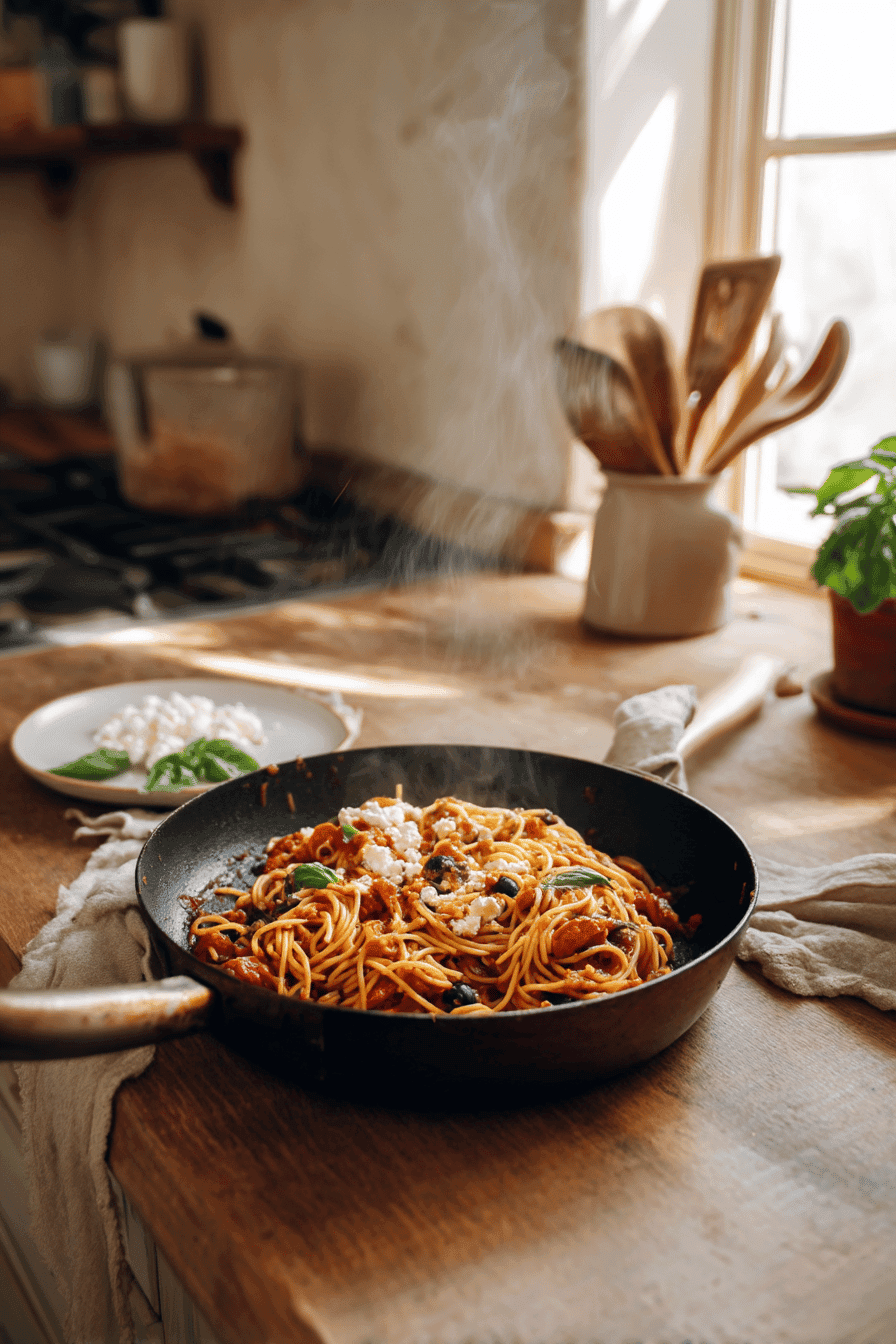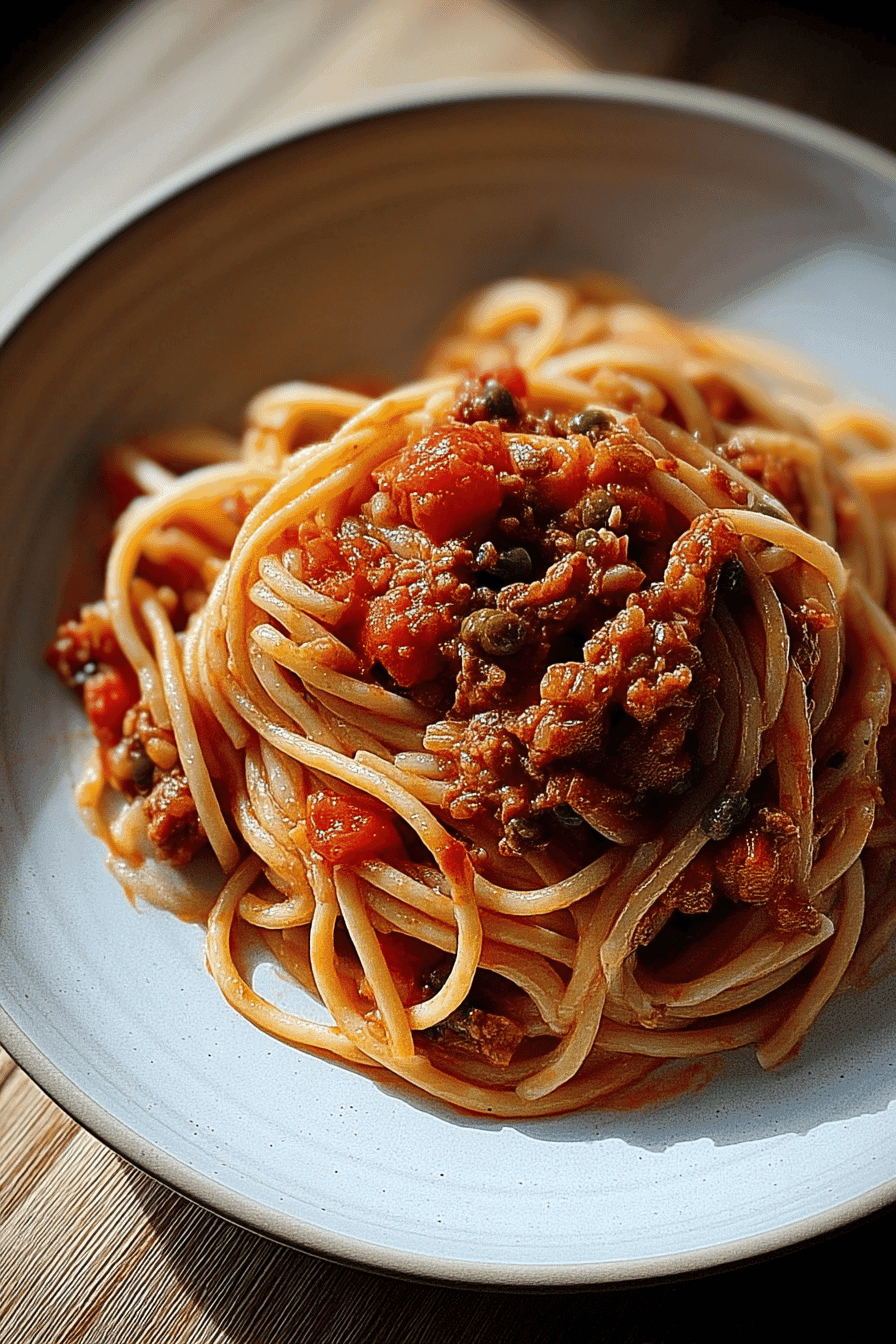Benefits and Advantages of Greek Style Spaghetti
Greek style spaghetti is a delightful dish that offers both ease of preparation and excellent health benefits, making it a fantastic choice for any meal. The recipe features simple yet flavorful ingredients that require minimal cooking time, perfect for busy weeknights or casual gatherings. Fresh vegetables, olives, and herbs provide antioxidants and healthy fats, promoting heart health and overall wellness. The balanced combination of carbohydrates from pasta, healthy fats from olive oil, and protein from cheese or optional meat creates a nutritious meal that supports energy and satiety.
This dish is highly versatile, easily adapted to vegan or gluten-free diets without sacrificing flavor, broadening its appeal. Its combination of fresh Mediterranean ingredients lets you enjoy authentic, wholesome flavors while maintaining nutritional balance. Including Greek style spaghetti in your meal rotation introduces a refreshing Mediterranean flair that nourishes both body and palate.
Jump to:
- Benefits and Advantages of Greek Style Spaghetti
- Essential Ingredients for Greek Style Spaghetti
- Dietary Substitutions to Customize Your Greek Style Spaghetti
- How to Prepare the Perfect Greek Style Spaghetti: Step-by-Step Guide
- Mastering Greek Style Spaghetti: Advanced Tips and Variations
- How to Store Greek Style Spaghetti: Best Practices
- Nutritional Value of Greek Style Spaghetti
- FAQs: Frequently Asked Questions About Greek Style Spaghetti
- What type of cheese should I use for authentic Greek style spaghetti?
- How do I store and reheat leftover Greek style spaghetti?
- Can I prepare the meat sauce and pasta ahead of time?
- What vegetables or meats can I add to Greek style spaghetti?
- How does Greek style spaghetti differ from traditional Italian spaghetti Bolognese?
- Greek Spaghetti with Authentic Meat Sauce Recipe for a Classic Mediterranean Meal
- Ingredients
- Instructions
- Last Step:
- Notes
- Nutrition
- Did you make this recipe?
Essential Ingredients for Greek Style Spaghetti
- 8 ounces (about 225 g) spaghetti or gluten-free pasta
- 6 tablespoons extra virgin olive oil
- 3 cloves garlic, minced
- 1½ pounds (about 680 g) seeded tomatoes cut into ½-inch pieces
- ½ cup (about 75 g) pitted olives, such as kalamata, sliced
- ¼ pound (115 g) crumbled feta cheese (vegan feta can be substituted)
- 3 tablespoons drained capers
- 3 tablespoons chopped fresh parsley
- ¼ teaspoon salt
- ¼ teaspoon freshly ground black pepper
- Fresh basil leaves for garnish
These ingredients combine to create authentic Mediterranean flavors with a balanced nutrient profile. Olive oil provides heart-healthy monounsaturated fats; garlic and oregano contribute antioxidants, while tomatoes add vitamin C and natural sweetness. The inclusion of olives and feta cheese adds saltiness and creaminess, which can be customized for dietary preferences.

Dietary Substitutions to Customize Your Greek Style Spaghetti
Greek style spaghetti can be adapted easily based on personal dietary needs or ingredient availability. For gluten-free diets, substitute traditional wheat pasta with gluten-free options made from rice, corn, or legumes; these cook similarly and maintain texture. Vegans may replace feta cheese with vegan cheese alternatives or nutritional yeast to retain a tangy, savory element. For lower-calorie versions, reduce the amount of olive oil or use cooking spray to limit fats without sacrificing moisture.
If you prefer to avoid olives, capers offer a great salty alternative, or sun-dried tomatoes can lend a sweet and tangy twist. To boost protein content, introduce chickpeas or white beans, complementing the dish’s Mediterranean theme. These substitutions allow you to enjoy Greek style spaghetti tailored to your diet without losing its hallmark taste and integrity.

How to Prepare the Perfect Greek Style Spaghetti: Step-by-Step Guide
- Cook the Pasta: Bring a large pot of salted water to a boil. Add spaghetti or gluten-free pasta and cook according to package instructions until al dente. Drain and set aside.
- Sauté Garlic: In a large skillet, heat extra virgin olive oil over medium heat. Add minced garlic and sauté for about 1 minute until fragrant, taking care not to burn it.
- Cook Tomatoes: Add the halved or chopped seeded tomatoes into the skillet and cook for 3 to 4 minutes until the tomatoes soften and release their juices.
- Add Greens: Stir in fresh spinach (or substitute greens like kale if preferred) and cook until wilted, about 2 minutes.
- Combine Olives and Seasoning: Add pitted and sliced olives along with dried oregano. Stir to combine and let the mixture cook for an additional 2 minutes to blend flavors.
- Toss Pasta: Add the cooked spaghetti to the skillet and toss thoroughly to coat the pasta evenly with the tomato and olive mixture.
- Season: Taste and season with salt and black pepper as needed.
- Add Cheese: Remove from heat and sprinkle crumbled feta cheese over the pasta. For vegan versions, use vegan feta or omit the cheese entirely.
- Garnish and Serve: Top with fresh basil leaves for aroma and visual appeal. Serve immediately for best flavor and texture.
This straightforward method ensures vibrant Mediterranean flavors with flexibility for customization, suited for home cooks seeking a quick yet delicious meal.
Mastering Greek Style Spaghetti: Advanced Tips and Variations
To master Greek style spaghetti, begin by using high-quality extra virgin olive oil, which significantly enhances the dish’s flavor. For added depth, try roasting garlic before sautéing to impart a milder, nuttier aroma. Toasted pine nuts or walnuts add a delightful crunchy texture contrast that complements the softness of pasta and vegetables.
Introducing protein such as grilled chicken or sautéed shrimp can make the dish more filling while keeping the authentic Mediterranean flair. To boost sweetness and color, incorporate roasted red peppers or sun-dried tomatoes. A touch of heat can be achieved by adding red pepper flakes during garlic sautéing.
For those adapting to vegan or low-fat diets, substitute feta cheese with nut-based cheeses and reduce the olive oil quantity accordingly. Always finish the dish with fresh herbs like basil or oregano for a vibrant, aromatic lift. These tips and variations allow you to personalize Greek style spaghetti while preserving its traditional charm.
How to Store Greek Style Spaghetti: Best Practices
Greek style spaghetti should be stored to maintain freshness and flavor. Refrigerate leftovers in an airtight container for up to 3-4 days. For longer preservation, freeze the cooled spaghetti in freezer-safe containers or heavy-duty plastic bags, ensuring as much air as possible is removed to prevent freezer burn. Frozen spaghetti lasts for up to 2 months.
When reheating, thaw the spaghetti in the refrigerator overnight or use the microwave’s defrost setting. Warm gently on the stovetop over low heat, stirring occasionally and adding a splash of water or olive oil to restore moisture if needed. Avoid overheating to prevent the pasta from drying out. These methods help keep Greek style spaghetti delicious and enjoyable for future meals.
Nutritional Value of Greek Style Spaghetti
| Nutrient | Amount per Serving |
|---|---|
| Calories | 350-400 kcal |
| Protein | 12-15 g |
| Fat | 14 g (mostly monounsaturated) |
| Carbohydrates | 45-50 g |
| Fiber | 4-6 g |
| Vitamin C | Varies (from tomatoes, olives, and herbs) |
| Calcium | Moderate (from feta cheese) |
| Antioxidants | Rich (from olive oil, garlic, herbs) |
This dish provides a balanced combination of macronutrients with healthy fats coming mainly from olive oil and olives, supporting heart health. The dietary fiber and antioxidants from fresh vegetables and herbs contribute to digestive health and overall wellness. The protein is moderate, especially when including feta cheese or plant-based substitutes. Incorporating Greek style spaghetti aligns well with the Health Benefits of Mediterranean Diet, supporting balanced nutrition and vitality.

FAQs: Frequently Asked Questions About Greek Style Spaghetti
What type of cheese should I use for authentic Greek style spaghetti?
How do I store and reheat leftover Greek style spaghetti?
Can I prepare the meat sauce and pasta ahead of time?
What vegetables or meats can I add to Greek style spaghetti?
How does Greek style spaghetti differ from traditional Italian spaghetti Bolognese?

Greek Spaghetti with Authentic Meat Sauce Recipe for a Classic Mediterranean Meal
🍝 Enjoy the vibrant flavors of this Greek Spaghetti with Authentic Meat Sauce, a classic Mediterranean delight.
🇬🇷 Experience a taste of Greece with a hearty, aromatic dish full of wholesome ingredients!
- Total Time: 40 minutes (vegetarian), 1 hour 30 minutes (meat sauce including simmering)
- Yield: 4 servings 1x
Ingredients
Vegetarian Version:
1½ lbs seeded tomatoes, cut into ½-inch pieces
½ cup pitted olives
¼ lb crumbled feta cheese
3 tablespoons drained capers
3 tablespoons chopped parsley
¼ teaspoon salt
¼ teaspoon black pepper
¾ lb spaghetti
6 tablespoons olive oil
3 cloves garlic, minced
Meat Sauce Version (Makaronia me Kima):
⅓ to ½ cup extra virgin olive oil
3 tablespoons olive oil (for pasta)
1 small onion, chopped
2–3 cloves whole
2–3 allspice berries
1 cinnamon stick
1–2 bay leaves
3 cloves garlic, halved
½ cup dry red wine
2 tablespoons tomato paste
1 pound ground beef
14–15 oz crushed or diced tomatoes
1 teaspoon fine sea salt
½ teaspoon black pepper
1 teaspoon sugar
1 cup hot water
1 tablespoon dried oregano
1 package (16 oz or 500 g) spaghetti
4 tablespoons grated mizithra or Pecorino cheese
¼ teaspoon ground cinnamon
Instructions
Vegetarian Version:
1. In a large bowl, mix tomatoes, olives, feta, capers, parsley, salt, and pepper.
2. Cook spaghetti according to package until al dente; drain.
3. Heat olive oil over moderately low heat; add garlic and cook for one minute.
4. Toss spaghetti with garlic oil and tomato mixture; serve warm or at room temperature.
Meat Sauce Version:
1. Heat olive oil in a pot over medium, add onion, cloves, allspice, cinnamon stick, bay leaves, and salt; sauté until onions are translucent.
2. Add garlic and cook for another minute.
3. Stir in tomato paste, then ground beef; cook until no longer pink.
4. Add red wine, cook until evaporated, then add tomatoes, salt, pepper, sugar, and hot water. Simmer uncovered for about one hour.
5. Remove whole spices and stir in oregano.
6. Boil spaghetti slightly beyond al dente, drain, and toss with olive oil.
7. In a casserole dish, layer half the pasta, sprinkle with cheese, add remaining pasta, sprinkle more cheese, and dust with cinnamon.
8. Heat remaining olive oil until shimmering and drizzle over pasta.
9. Serve with meat sauce spooned generously on top.
Last Step:
Please leave a rating and comment letting us know how you liked this recipe! This helps our business to thrive and continue providing free, high-quality recipes for you.Notes
🍝 Always cook pasta to al dente for texture, adjust for casseroles.
🌿 Use gluten-free pasta for dietary preferences; add eggplant or zucchini for variety.
🌶️ Spice up with cayenne or red pepper flakes for an extra kick.
- Prep Time: 20 minutes (vegetarian), 1 hour 10 minutes (meat sauce)
- Simmering (for meat sauce): 1 hour
- Cook Time: 20 minutes (vegetarian), 20 minutes (active meat sauce)
- Category: Main Course
- Method: Boiling and Sautéing
- Cuisine: Mediterranean
- Diet: Pescatarian (vegetarian version), Omnivore (meat version)
Nutrition
- Serving Size: 1 plate
- Calories: 420 kcal (vegetarian), 650 kcal (meat sauce)
- Sugar: 5 grams
- Sodium: 620 mg
- Fat: 14 grams (vegetarian), 28 grams (meat sauce)
- Saturated Fat: 6 grams (vegetarian), 10 grams (meat sauce)
- Unsaturated Fat: 8 grams (vegetarian), 18 grams (meat sauce)
- Trans Fat: 0 grams
- Carbohydrates: 62 grams
- Fiber: 5 grams
- Protein: 15 grams (vegetarian), 30 grams (meat sauce)
- Cholesterol: 30 mg (vegetarian), 60 mg (meat sauce)







